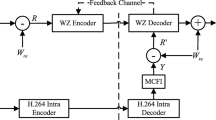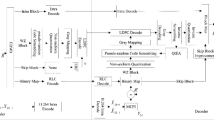Abstract
Distributed Video Coding (DVC) is a video coding paradigm in which the computational complexity is shifted from the encoder to the decoder. DVC is based on information theoretic results suggesting that, under ideal conditions, the same rate-distortion performance can be achieved as for traditional video codecs. In practice however, there is still a significant performance gap between the two coding architectures. One of the main reasons for this gap is the lack of multiple coding modes in current DVC solutions. In this paper, we propose a block-based distributed video codec that supports three coding modes: Wyner–Ziv, skip, and intra. The mode decision process is entirely decoder-driven. Skip blocks are selected based on the estimated accuracy of the side information. The choice between intra and Wyner–Ziv coding modes is made on a rate-distortion basis, by selecting the coding mode with the lowest rate while assuring equal distortion for both modes. Experimental results illustrate that the proposed block-based architecture has some advantages over classical bitplane-based approaches. Introducing skip and intra coded blocks yields average bitrate gains of up to 33.7% over our basic configuration supporting Wyner–Ziv mode only, and up to 29.7% over the reference bitplane-based DISCOVER codec.












Similar content being viewed by others
Notes
Therefore, DVC is often referred to as Wyner–Ziv (WZ) coding, and the independently encoded/jointly decoded frames in a DVC codec are called WZ frames.
\(\textrm{precision} = \frac{\textrm {true positives}}{\textrm{true positives + false positives}}\); \(\textrm{recall} = \frac{\textrm{true positives}}{\textrm{true positives + false negatives}}\)
By side information block, we refer to the blocks to which a bidirectional motion vector was assigned during the side information generation. In the proposed codec, side information blocks are 8 × 8 pixels.
This is valid for a GOP size 4. More sets will be required for longer GOPs.
Experiments showed that considering two frames yields good results. Adding more frames does not improve the performance.
http://enpub.fulton.asu.edu/ivu/Software/DVC/BLASTDVC/BLAST.htm (accessed December 1, 2010).
References
Aaron A, Rane S, Setton E, Girod B (2004) Transform-domain Wyner–Ziv codec for video. In: Proc. SPIE visual communications and image processing
Artigas X, Ascenso J, Dalai M, Klomp S, Kubasov D, Ouaret M (2007) The DISCOVER codec: architecture, techniques and evaluation. In: Proc. picture coding symposium (PCS)
Ascenso J, Brites C, Pereira F (2005) Improving frame interpolation with spatial motion smoothing for pixel domain distributed video coding. In: Proc. 5th EURASIP conference on speech and image processing, multimedia communications and services
Ascenso J, Pereira F (2009) Low complexity intra mode selection for efficient distributed video coding. In: Proc. international conference on multimedia and expo (ICME)
Belkoura Z, Sikora T (2006) Improving Wyner–Ziv video coding by block-based distortion estimation. In: Proc. European signal processing conference
Benierbah S, Khamadja M (2009) Hybrid Wyner–Ziv and intra video coding with partial matching motion estimation at the decoder. In: Proc. IEEE international conference on image processing (ICIP)
Chien W-J, Karam L (2010) BLAST-DVC: BitpLAne SelecTive distributed video coding. Multimed Tools Appl 48(3):437–456
Chien W-J, Karam L, Abousleman G (2007) Block-adaptive wyner-ziv coding for transform-domain distributed video coding. In: Proc. IEEE international conference on acoustics, speech and signal processing (ICASSP)
Do T, Shim HJ, Jeon B (2009) Motion linearity based skip decision for Wyner–Ziv coding. In: Proc. international conference on computer science and information technology
Esmaili G, Cosman P (2009) Low complexity spatio-temporal key frame encoding for Wyner–Ziv video coding. In: Proc. data compression conference (DCC)
Feng Y, Li Y, Wu C, Song R (2008) Coding scheme with skip mode based on motion filed detection for dvc. In: Proc. satellite data compression, communication, and processing IV
Girod B, Aaron A, Rane S, Rebollo-Monedero D (2005) Distributed video coding. Proc IEEE 93(1):71–83
Jakubowski M (2009) Constant rate control algorithm for wyner-ziv video codec. In: Proc. photonics applications in astronomy, communications, industry, and high-energy physics experiments 2009
Kubasov D, Lajnef K, Guillemot C (2007) A hybrid encoder/decoder rate control for a Wyner–Ziv video codec with a feedback channel. In: Proc. IEEE multimedia signal processing workshop
Ma S, Gao W, Lu Y (2005) Rate-distortion analysis for h.264/avc video coding and its application to rate control. IEEE Trans Circuits Syst Video Technol 15(12):1533–1544
Mys S, Slowack J, Škorupa J, Lambert P, Van de Walle R (2009) Introducing skip mode in distributed video coding. Signal Process, Image Commun 24(3):200–213
Pereira F, Torres L, Guillemot C, Ebrahimi T, Leonardi R, Klomp S (2008) Distributed video coding: selecting the most promising application scenarios. Signal Process, Image Commun 23(5):339–352
Puri R, Majumdar A, Ramchandran K (2007) PRISM: a video coding paradigm with motion estimation at the decoder. IEEE Trans Image Process 16(10):2436–2448
Puri R, Ramchandran K (2002) PRISM: a new robust video coding architecture based on distributed compression principles. In: Proc. Allerton conference on communication, control and computing
Puri R, Ramchandran K (2003) PRISM: a “reversed” multimedia coding paradigm. In: Proc. IEEE international conference on image processing (ICIP)
Slepian D, Wolf JK (1973) Noiseless coding of correlated information sources. IEEE Trans Inf Theory 19(4):471–480
Slowack J, Mys S, Škorupa J, Lambert P, Grecos C, Van de Walle R (2009) Accounting for quantization noise in online correlation noise estimation for distributed video coding. In: Proc. picture coding symposium (PCS)
Sofke S, Pereira F, Müller E (2009) Dynamic quality control for transform domain Wyner–Ziv video coding. EURASIP Journal on Image and Video Processing, Special Issue: Distributed Video Coding 2009:1–15
Tagliasacchi M, Pedro J, Pereira F, Tubaro S (2007) An efficient request stopping method at the turbo decoder in distributed video coding. In: Proc. EURASIP European signal processing conference
Tagliasacchi M, Trapanese A, Tubaro S, Ascenso J, Brites C, Pereira F (2006) Intra mode decision based on spatio-temporal cues in pixel domain Wyner–Ziv video coding. In: Proc. IEEE international conference on acoustics, speech, and signal processing (ICASSP)
Trapanese A, Tagliasacchi M, Tubaro S, Ascenso J, Brites C, Pereira F (2005) Embedding a block-based intra mode in frame-based pixel domain Wyner–Ziv video coding. In: Proc. international workshop on very low bitrate video
Tsai D-C, Lee C-M, Lie W-N (2007) Dynamic key block decision with spatio-temporal analysis for Wyner–Ziv video coding. In: Proc. IEEE international conference on image processing (ICIP)
Škorupa J, Slowack J, Mys S, Lambert P, Grecos C, Van de Walle R (2009) Stopping criterions for turbo coding in a Wyner–Ziv video codec. In: Proc. picture coding symposium (PCS)
Wiegand T, Sullivan GJ, Bjø ntegaard G, Luthra A (2003) Overview of the H.264/AVC video coding standard. IEEE Trans Circuits Syst Video Technol 13(7):560–576
Wyner AD, Ziv J (1976) The rate-distortion function for source coding with side information at the decoder. IEEE Trans Inf Theory 22(1):1–10
Acknowledgements
The research activities that have been described in this paper were funded by Ghent University, the Interdisciplinary Institute for Broadband Technology (IBBT), the Institute for the Promotion of Innovation by Science and Technology in Flanders (IWT-Flanders), the Fund for Scientific Research-Flanders (FWO-Flanders), and the European Union.
Author information
Authors and Affiliations
Corresponding author
Rights and permissions
About this article
Cite this article
Mys, S., Slowack, J., Škorupa, J. et al. Decoder-driven mode decision in a block-based distributed video codec. Multimed Tools Appl 58, 239–266 (2012). https://doi.org/10.1007/s11042-010-0718-5
Published:
Issue Date:
DOI: https://doi.org/10.1007/s11042-010-0718-5




